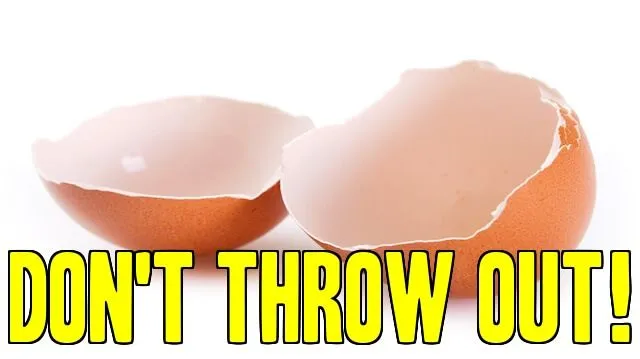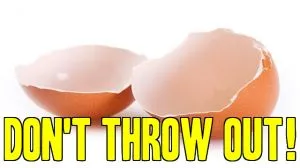
- Share on Facebook3174
- Share on Pinterest
- Share on Twitter
We’ve all been told time and time again that we must consume calcium in order to have healthy bones. Many of us were made to drink a glass of milk with dinner as a kid, and probably include calcium in our supplement regimen. In fact, the United States is one of the highest consumers of dairy products per capita worldwide, and calcium is one of the country’s best-selling supplements.
It may come as a surprise that the incidence of osteoporosis in America is actually amongst the highest in the world, despite all the dairy and calcium consumption that should supposedly guarantee good bone health. This would suggest that there is a flaw in the strategies we are using to prevent osteoporosis. With one in four American women aged 65 or older diagnosed as having lost at least 50 percent of their bone mass, we are sorely in need of better ways to preserve healthy bones.
This is where eggshells come in! Let’s explore the importance of sufficient calcium in the body, and why eggshells might just be the ideal go-to source.
And no, we don’t expect you to start eating scrambled eggs “with a crunch”! Read on to find out how to integrate this nutritional powerhouse into your diet, rather than just chucking it in the trash.
How calcium functions in the body
While most of our calcium resides in our bones and teeth, it’s also important for muscle contraction, nerve health, enzyme activity, hormone signaling, maintenance of heartbeat and circulation, and the formation of cells. Almost every cell and mechanism in the human body makes use of calcium in some way.
There is a certain amount of calcium floating around in the blood at all times. Our bones are built of calcium (and other things), but they are also able to store extra calcium in case the blood calcium gets too low.
Problems if you are lacking calcium
The body pulls calcium from the bones and teeth when levels in the blood are not sufficiently high for all the important activities for which calcium is needed. This “leaching” of calcium from the bones can happen even if there is a lot of calcium being consumed in the diet or via supplements — if it’s not being consumed in a way that the body can use or absorb.
While not having enough calcium can cause issues such as increased risk of fractures, numbness and irregular heart rhythms, over-consuming calcium can also result in health problems.
This is especially true when calcium’s cofactors are not present. Calcium needs enough magnesium and vitamin D to be used by the body. It also requires vitamin K2, which acts as a dispatcher for calcium, telling it where to go in the system. If there is too much “free” calcium floating around without those other regulating nutrients, the calcium can end up forming deposits, such as kidney stones, gallstones, or calcification in soft tissues.
We should take care to consume vitamin D3 along with calcium for the best absorption. Studies show this combination has the best result in increasing calcium metabolism. This is because vitamin D increases the mechanisms for absorbing calcium in the intestines.
Problems caused by calcium supplements
Researchers have found that calcium supplements function differently in the body than calcium from food sources. Studies have found that people who consume high amounts of calcium, particularly from supplements, might have an increased risk of heart disease. This is likely because the overload of chemically isolated calcium causes calcification, or hardening, of the arteries and heart muscles. The incidence in kidney and gallstones has also been found to be associated with high calcium consumption from supplements, but not from food.
It is much better to get calcium from food sources, such as organic dairy products (milk, yogurt and cheese), leafy green vegetables (kale, broccoli or cabbage), or fish with edible soft bones (canned sardines and salmon often have bones soft enough to consume). Powdered egg shells are also a fantastic source of whole food calcium.
Why eggshell calcium is good
 Eggshell powder is a natural source of calcium, 27 nutritional elements, and other bone-strengthening constituents, such as strontium and fluorine. In fact, the composition of eggshell is very similar to that of our teeth and bones. These nutrients are highly bioavailable, meaning the body can digest and use them effectively since they are in the form of a whole food.
Eggshell powder is a natural source of calcium, 27 nutritional elements, and other bone-strengthening constituents, such as strontium and fluorine. In fact, the composition of eggshell is very similar to that of our teeth and bones. These nutrients are highly bioavailable, meaning the body can digest and use them effectively since they are in the form of a whole food.
Studies have shown a number of positive properties of eggshell powder, such as the ability to prevent and cure rickets (a bone deformation disease) in rats and humans. Animal studies also showed a positive effect on bone density in those with osteoporosis, and increased cell production and growth in cartilage. Similar findings from another study included reduced pain and improved mobility for osteoporosis sufferers.
Although studies have focused on disease conditions, we can definitely use eggshell calcium in a preventative way as well, to hold off any tooth, joint or bone problems.
How to make eggshell calcium
Making a powder out of eggshells is the easiest way to consume them. Read on for some ideas on how to use your homemade, whole food, calcium supplement.
Ingredients and equipment:
- 1 carton of organic pastured chicken eggs — you can identify good quality eggs by a healthy thick shell, which indicates the chickens have been fed a supportive diet and they are not exhausted from laying too much.
- Stock pot
- Coffee grinder
- 1 small Mason jar with secure lid
Directions:
1. Use up your eggs as you normally would, keeping the shell in the carton to make your supplement.
2. When you have your dozen shells, rinse them well in water. Remove any whites that might be stuck, but don’t remove membrane as these have extra nutrients.
3. Fill a stock pot with approximately 6 cups of filtered water and bring to a boil.
4. Carefully put your eggshells into water. This will kill any harmful pathogens.
5. Let cook for 10 minutes, then drain shells.
6. Spread the shells on a glass or stainless steel baking sheet and let dry overnight. In the morning, put in a 200°F oven for about 10 minutes to completely dry out.
7. Once completed, put a few shells into a coffee grinder and run until they are pulverized into a granular form. Continue until all of your shells are powder.
8. Store in a tightly sealed Mason jar in the cupboard away from heat or moisture.
How to consume eggshell calcium
One teaspoon contains approximately 800–1,000 mg of calcium. Consume by mixing in a small amount of water with a meal. Consume 3/4 to one teaspoons daily, divided in three servings with meals. Don’t consume more than one teaspoon a day as it can irritate sensitive digestive tracts or cause constipation.
Other things to do with eggshells
If you eat a lot of eggs, as is typical with a whole food, ancestral, or paleo-style diet, you may find you have a lot of eggshells going to waste! Luckily there are even more clever ways to use eggshells.
- Feed them to your chickens—Homesteaders have found that chickens prefer to eat powdered egg shells over the oyster supplements that are often recommended to maintain good health.
- Use the shell’s membrane as an all-natural bandage.
- Sprinkle the eggshells around your garden to deter pests.
- Give your tomatoes a calcium boost—This prevents blossom-end rot, which is a common tomato problem caused by calcium deficiency. Simply place crushed eggshells in the bottom of the hole when transplanting.
- You can also add egg shells to potting soil along with coffee grounds.
- The powder can be fed to dogs for extra nutrition and to help medicate diarrhea.
- You can also add the powder to smoothies, soups or broths, or make capsules out of them. Simply buy empty gelatin or vegetable capsules and fill with the eggshell powder.
- Use the powder in homemade remineralizing toothpaste.
- Make homemade sidewalk chalk with eggshell powder, hot water, flour and food coloring.
- Soak eggshells in water and then use the mineral-rich water on houseplants and flowers.
- Use sterilized and crushed egg shells as a supplement in wild bird feed.
There are so many wonderful ways to use eggshells rather than throwing them in the garbage. Hopefully you’ve found inspiration and opportunities for better health plus sustainability!
-The Alternative Daily
Sources:
http://www.ncbi.nlm.nih.gov/pubmed/11281164
http://www.ncbi.nlm.nih.gov/pubmed/15018022
http://www.mamanatural.com/how-to-make-eggshell-calcium
http://www.theprairiehomestead.com/2012/08/9-things-to-do-with-eggshells.html
http://www.nlm.nih.gov/medlineplus/ency/article/002412.htm
http://www.medicine.wisc.edu/rheumatology/hansenresearchcalcium
http://www.webmd.com/vitamins-and-supplements/lifestyle-guide-11/supplement-guide-calcium
http://en.wikipedia.org/wiki/List_of_countries_by_milk_consumption_per_capita
http://www.ncbi.nlm.nih.gov/pmc/articles/PMC2957223/
http://foodmatters.tv/articles-1/the-truth-about-calcium-and-osteoporosis
http://ods.od.nih.gov/factsheets/Calcium-Consumer/#h6
- Share on Facebook3174
- Share on Pinterest
- Share on Twitter

